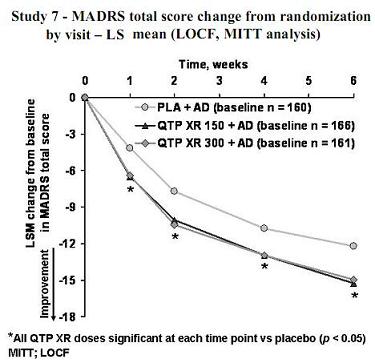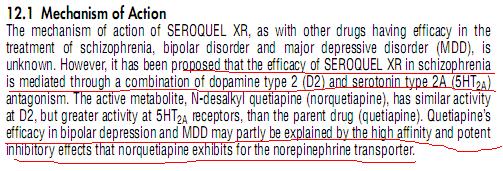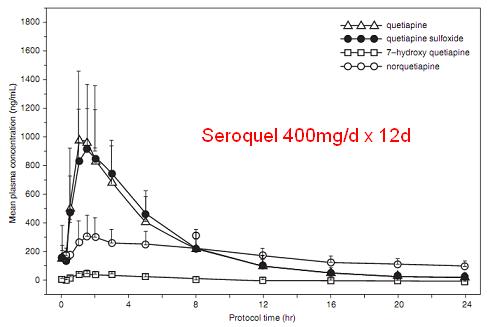February 4, 2010
How Seroquel XR Works, Part 1
When evidence based medicine results in a government sanctioned lie.
1. What is the clinical data on Seroquel's efficacy as an antidepressant?
In order to get an indication, the FDA requires at least 2 randomized controlled trials. Both were identical in design, and nearly the same in outcome.
Patients who were on an SSRI or SNRI, who were not improving after 6 weeks, were randomized to the addition of Seroquel XR 150mg/d, 300mg/d or placebo (along with the maintaining of their previous antidepressant at previous dose.) The results:

On the basis of this, and the other similar study, the FDA approved Seroquel XR as an adjunct to other antidepressant in MDD.
2. Is this a function of its antipsychotic properties?
No. At 150mg/d there is very little D2 blockade; and not all antipsychotics have been able to show efficacy as an adjunct in MDD. Some other mechanism is likely.
3. How is Astra Zeneca and the FDA explaining the efficacy?
Not an easy question to answer. Any proposed mechanism must be accepted by the FDA; once a mechanism is proposed and placed in the package insert (and promotional materials), it cannot be changed without resubmitting to the FDA-- even in the face of contradictory proof. For this reason, e.g. they are vague on the mechanism in schizophrenia:

All of Seroquel XR's promotional materials, the package insert, and the clinical trials describe the efficacy as the result of Seroquel's effect on norepinephrine and the NET.
4. What is the evidence for the proposition that Seroquel's antidepressant effect is mediated by norepinephrine?
Quetiapine is partially metabolized to norquetiapine. Any pharmacologic (i.e. receptor) description of the Seroquel's effect must therefore include norquetiapine.

Quetiapine does not bind to the NET; but norquetiapine, its chief metabolite, is a potent inhibitor if it. Tricyclics, Effexor, and Cymbalta all have considerable NET inhibition as well. It's logical to conclude that when you eat a Seroquel, and it gets metabolized to norquetiapine, that it would then exert some action on the NET.
5. At a clinically relevant dose of Seroquel, how much norquetiapine is there?
Not much.
The package insert states:

Levels of norquetiapine did not differ IR vs. XR.
6. What amount of NET inhibition occurs at 400ng/ml? Show your work.
300ng/ml= 300ug/L
300ug/L= 0.0003g/L
MW norquetiapine = 295.4 g/mol
0.0003g/L x 1 mol/295.4g = 1.02e-6M = 1015nM
Norquetiapine's Ki for the NET inhibition is between 12-35 nM, depending on in vitro or in vivo.
At clinically relevant doses, the NET is more than completely occupied.
7. Wow, really?
No, not really.
It appears that, in contrast to the longstanding paradigm of post-Kohut modern psychiatry, there is more to the human body than serotonin and norepinephrine receptors. I'm as terrified as you are. I don't know what to believe anymore.
A study measured the NET occupancy to Seroquel and norquetiapine (administered independently) in monkeys after a single dose. Norquetiapine produced 80% occupancy of the NET at low concentrations.
However, in the nine suckers induced to participate in this other study, 300mg Seroquel XR for 7 days generated 300nM concentrations of norquetiapine (as predicted above) and 35% NET occupancy in the thalamus. 150mg Seroquel XR-- the dose at which it functions as an antidepressant-- resulted in 19% occupancy. That's not very much.
Consider that if Seroquel is metabolized to norquetiapine in monkeys as well, then a clinically relevant dose of Seroquel should produce clinically meaningful occupancy of NET (by the effect of its metabolite.) It didn't.
The actual occupancy of the NET after 300mg Seroquel XR is quite low, 150mg even lower.
8. Can you compare this to the occupancy of something I know-- like Effexor?
NET PET studies aren't as easy to do as DA studies, because many of the ligands used in the experiments bind nonspecifically and produce greater background binding. There's also not an obvious negative to compare it to (e.g. there aren't any DAT in the cerebellum, so that becomes your control in DAT experiments.) Radioligands specific for NET are only recently becoming used; Effexor doesn't have available PET data because now that there are such ligands for use in a study, Wyeth doesn't exist to pay for them. Take that, unbiased research.
Understanding that the comparisons are not entirely fair, a blood assay in depressed humans found that after 8 weeks of Effexor 150mg, NET inhibition was 50%. At 375mg, it was 60%. Paxil, an "SSRI", blocked about 30% at 75mg. Note that Effexor is only 55% protein bound (Seroquel is 80%) and thus in a real patient, there is more free Effexor to exert activity on the NET, which may be why it has such a larger effect on the NET despite a theoretically weak Ki (2200nM).
Despite this, the NET occupancy of a clinically efficacious dose of Seroquel XR (150mg) is likely too low to be the main cause of its antidepressant efficacy.
Part 2 here.
In order to get an indication, the FDA requires at least 2 randomized controlled trials. Both were identical in design, and nearly the same in outcome.
Patients who were on an SSRI or SNRI, who were not improving after 6 weeks, were randomized to the addition of Seroquel XR 150mg/d, 300mg/d or placebo (along with the maintaining of their previous antidepressant at previous dose.) The results:

On the basis of this, and the other similar study, the FDA approved Seroquel XR as an adjunct to other antidepressant in MDD.
2. Is this a function of its antipsychotic properties?
No. At 150mg/d there is very little D2 blockade; and not all antipsychotics have been able to show efficacy as an adjunct in MDD. Some other mechanism is likely.
3. How is Astra Zeneca and the FDA explaining the efficacy?
Not an easy question to answer. Any proposed mechanism must be accepted by the FDA; once a mechanism is proposed and placed in the package insert (and promotional materials), it cannot be changed without resubmitting to the FDA-- even in the face of contradictory proof. For this reason, e.g. they are vague on the mechanism in schizophrenia:

All of Seroquel XR's promotional materials, the package insert, and the clinical trials describe the efficacy as the result of Seroquel's effect on norepinephrine and the NET.
4. What is the evidence for the proposition that Seroquel's antidepressant effect is mediated by norepinephrine?
Quetiapine is partially metabolized to norquetiapine. Any pharmacologic (i.e. receptor) description of the Seroquel's effect must therefore include norquetiapine.

Quetiapine does not bind to the NET; but norquetiapine, its chief metabolite, is a potent inhibitor if it. Tricyclics, Effexor, and Cymbalta all have considerable NET inhibition as well. It's logical to conclude that when you eat a Seroquel, and it gets metabolized to norquetiapine, that it would then exert some action on the NET.
5. At a clinically relevant dose of Seroquel, how much norquetiapine is there?
Not much.
The package insert states:
The Cmax and AUC of norquetiapine are about 21-27% and 46-56% of that observed for quetiapine.Or, graphically (from Winter J Child Adol Psychopharm 2008):

Levels of norquetiapine did not differ IR vs. XR.
6. What amount of NET inhibition occurs at 400ng/ml? Show your work.
300ng/ml= 300ug/L
300ug/L= 0.0003g/L
MW norquetiapine = 295.4 g/mol
0.0003g/L x 1 mol/295.4g = 1.02e-6M = 1015nM
Norquetiapine's Ki for the NET inhibition is between 12-35 nM, depending on in vitro or in vivo.
At clinically relevant doses, the NET is more than completely occupied.
7. Wow, really?
No, not really.
It appears that, in contrast to the longstanding paradigm of post-Kohut modern psychiatry, there is more to the human body than serotonin and norepinephrine receptors. I'm as terrified as you are. I don't know what to believe anymore.
A study measured the NET occupancy to Seroquel and norquetiapine (administered independently) in monkeys after a single dose. Norquetiapine produced 80% occupancy of the NET at low concentrations.
However, in the nine suckers induced to participate in this other study, 300mg Seroquel XR for 7 days generated 300nM concentrations of norquetiapine (as predicted above) and 35% NET occupancy in the thalamus. 150mg Seroquel XR-- the dose at which it functions as an antidepressant-- resulted in 19% occupancy. That's not very much.
Consider that if Seroquel is metabolized to norquetiapine in monkeys as well, then a clinically relevant dose of Seroquel should produce clinically meaningful occupancy of NET (by the effect of its metabolite.) It didn't.
The actual occupancy of the NET after 300mg Seroquel XR is quite low, 150mg even lower.
8. Can you compare this to the occupancy of something I know-- like Effexor?
NET PET studies aren't as easy to do as DA studies, because many of the ligands used in the experiments bind nonspecifically and produce greater background binding. There's also not an obvious negative to compare it to (e.g. there aren't any DAT in the cerebellum, so that becomes your control in DAT experiments.) Radioligands specific for NET are only recently becoming used; Effexor doesn't have available PET data because now that there are such ligands for use in a study, Wyeth doesn't exist to pay for them. Take that, unbiased research.
Understanding that the comparisons are not entirely fair, a blood assay in depressed humans found that after 8 weeks of Effexor 150mg, NET inhibition was 50%. At 375mg, it was 60%. Paxil, an "SSRI", blocked about 30% at 75mg. Note that Effexor is only 55% protein bound (Seroquel is 80%) and thus in a real patient, there is more free Effexor to exert activity on the NET, which may be why it has such a larger effect on the NET despite a theoretically weak Ki (2200nM).
Despite this, the NET occupancy of a clinically efficacious dose of Seroquel XR (150mg) is likely too low to be the main cause of its antidepressant efficacy.
Part 2 here.
32 Comments